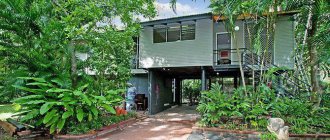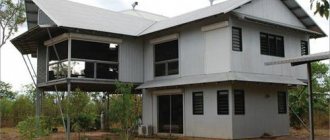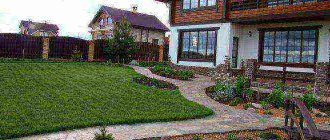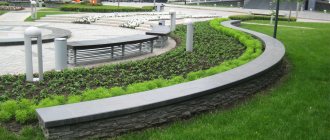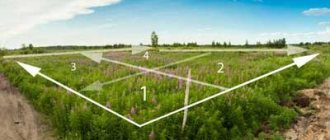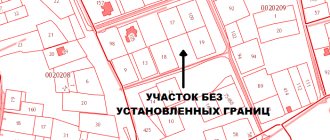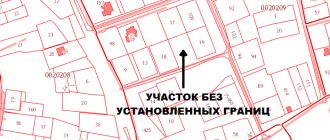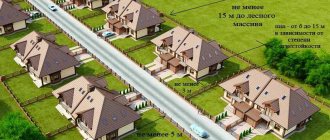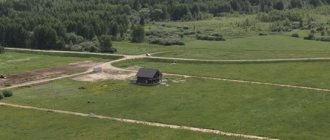Good afternoon, dear reader.
Today we will consider another controversial issue of traffic rules. We will talk about how to determine what is in front of your car: an intersection or an exit from the adjacent territory .
In fact, many drivers do not think about this issue until they find themselves in an ambiguous situation.
Let me remind you that the rules for driving through adjacent territories and intersections are somewhat different. For example, reversing at intersections is prohibited. The rules of priority when driving through equivalent intersections and exits from adjacent territories also differ.
In this article, we will look at signs that can accurately identify an intersection or surrounding area, as well as signs that do not give us any information about the roadway being crossed. Let's get started.
Concepts of intersection and surrounding area
Let's start by looking at the basic concepts that will be used in the article:
“Intersection” is a place where roads intersect, adjoin or branch at the same level, limited by imaginary lines connecting, respectively, the opposite, most distant from the center of the intersection, beginnings of curvatures of roadways. Exits from adjacent areas are not considered intersections.
“Adjacent territory” is the territory directly adjacent to the road and not intended for through traffic of vehicles (yards, residential areas, parking lots, gas stations, enterprises, etc.). Movement in the adjacent territory is carried out in accordance with these Rules.
So, according to these concepts, the main difference between an intersection and the surrounding area is the infrastructure facilities to which the intersecting roadway leads.
An example of an intersection (its panorama):
An example of the adjacent territory - leaving the yard (its panorama):
So, the two previous pictures did not cause you any difficulties, but in practice this is not always the case.
Parking and parking rules
Parking and parking rules depend on where exactly the road adjoins. That is, if it is adjacent to a residential building, then parking will be possible only in designated spaces. If they are absent, you can park cars on the sidewalk so that the vehicle does not interfere with the passage of pedestrians or the passage of other cars.
In all cases, you cannot park your car under the windows, close to the trash can, entrances to or exits from the building. It is strictly prohibited to block passages, entrances and exits.
It is prohibited to park trucks weighing more than 3.5 tons in adjacent areas.
| Did not find an answer to your question? Call a lawyer! Moscow: +7 (499) 755-83-41 St. Petersburg: +7 (812) 917-23-31 |
The key difference between the adjacent territory and the intersection is that it does not intersect with the roadway, but is adjacent to it. It is impossible to drive through the PT, which is why it is not a road.
Controversial road trips
Let's look at a couple of ambiguous situations (panorama 1 and panorama 2):
Look carefully at the pictures above and answer the question what is shown in each of them: an intersection or an exit from the adjacent territory?
Have you thought about it? Do you understand that everything is not so simple? In none of these examples is it possible to understand what is in front of us without taking the given exits. Those. The first conclusion that we will draw from the results of this article is that it is not always possible to understand what is in front of us: an intersection or the intersection of roadways.
Therefore, I propose to consider the signs that will help us further understand what kind of object is in front of us.
How many meters from the house is considered a local area?
From the fence.
Often developers install a special fence, thanks to which they protect the residents of an apartment building from strangers.
Sometimes no one is allowed into the aisles of the fence except the direct owners of the premises of the apartment building.
This measure allows you to protect the territory from prying eyes and, accordingly, debris, thereby prolonging its well-maintained condition for a long time.
Read more about who is responsible for cleaning the local area (yards) of an apartment building here.
How many meters from the fence is considered a local area and how many meters of local area can be allocated from the house to the immediate fence? To answer this question, you need to refer to the apartment building’s passport, which is kept by the management organization or the developer’s company.
This document indicates the size of the local area directly from the residential building to the installed fence.
What distance from the fence is considered a local area?
As a rule, the length of the distance from the house to the fence should not exceed 15 m. But sometimes the figures may vary.
More information about the local area and how to determine boundaries can be found here.
From the house.
How many meters from the house is considered the adjacent territory of an apartment building? Many residents want to establish the extent of the local area from the immediate home to the established restrictions. Many people believe that the local area should be limited to a couple of meters from the wall of the house. This is wrong.
Depending on which territory originally belonged to the developer’s company, the total size of the plot is determined. It is impossible to say unambiguously what frames a given area located near the house should contain.
Next to one building, the area of the adjacent territory of an apartment building may not exceed several square meters, while next to another building it can exceed tens or hundreds of square meters and accommodate many infrastructure facilities of an apartment building.
In order to form an opinion about what local area, or rather what its size, belongs directly to your home, you need to familiarize yourself with the land surveying documents, as well as the cadastral passport of the building.
Signs of an intersection
1. Traffic lights. Standard traffic lights, in accordance with GOST, are installed only at controlled intersections and controlled pedestrian crossings. They never regulate exits from adjacent territories.
2. Road signs 2.3.1-2.3.7 are installed only in front of intersections:
Also, sign 8.13 is installed only before intersections:
Please note that intersections have no other distinguishing features. For example, the “Give Way” or “Main Road” signs do not tell you anything specific, but more on that a little later.
Maximum and minimum size
The Town Planning Code does not clearly indicate what parameters a site in the local area should have. There are no strict data on what shape the plot should be and what its footage should be.
But the town planning code gives us the concept of the maximum and minimum size of a land plot owned by an apartment building.
Multi-storey buildings are built in different conditions, different areas and, accordingly, on different sites. It is not always possible for a development company to purchase a plot of land that would meet all the necessary requirements of future residents. This is where the concept of the minimum size of the local area of an apartment building comes from. Sometimes, a development company acquires a plot of land that is the size of a house.
Thus, when leaving the entrance, you immediately find yourself on territory that no longer belongs to your apartment building. That is, the minimum size of the building area is equal to the parameters of an apartment building.
As for the maximum size of the local area, it can vary from the minimum to the maximum. It can be limited only to other buildings that are not included in the infrastructure of the house, and the land survey plan. Unfortunately, the legislator did not leave any more specifics on this issue.
For more details about the standards for the size of the local area, read our article.
Signs of the surrounding area
The adjacent territory is not indicated by any road signs, so it can only be judged by the objects to which the road leads. For example, a gas station or parking lot may be located close to the road. These are adjacent areas.
However, it cannot be said that if there is a gas station on the side of the road, then you are driving into the adjacent territory. Let me give you an example to make this clearer:
Let's assume that our car is driving along a big road from right to left. At first glance, it may seem to the driver that the car leaving from above is leaving the gas station, i.e. leaves the surrounding area. In fact, this car is driving along a small road and arrives at an equivalent intersection. I think the idea is clear.
The second important conclusion: Not everything is adjacent to a gas station or a parking lot.
Possible accidents and their consequences
Road accidents in the adjacent territory of the traffic rules are not further described. But of course they happen there. And they are associated with the fact that drivers disagree on whether this is an intersection or an adjacent section. After all, the rules are different here and there. What accidents are typical in this situation:
- Car L is about to make a U-turn and enters an adjacent area in reverse. Car F follows from there, the driver of which is sure that he is going through the intersection. Therefore, he does not yield to his opponent, and as a result a collision occurs. If it is an adjacent area, the second motorist will be punished. He should have let car L pass. If it was an intersection, the blame would be placed on the driver of the first car. Reversing is prohibited in this section.
- Car L, leaving the adjacent zone, turns right. Car F is coming towards him and intends to go left. If the first one is sure that everything is happening at the intersection of equivalent paths, and the second one evaluates the area as an adjacent zone, a collision is possible. When driver L is right, the opponent must let him pass in accordance with paragraph 13.12 of the traffic rules:
When turning left or making a U-turn, the driver of a trackless vehicle is obliged to give way to vehicles moving on an equivalent road from the opposite direction straight or to the right.
But when we are talking about the adjacent territory, it is the car F that should go first. After all, L leaves it, which means it is inferior to all other vehicles.
- Car L drove into a gas station, refueled, turned around and was about to leave the same way. At this time, car F follows there and an accident occurs. Driver L is wrong here. If exit is allowed along the same route, he must let F through. But sometimes it is necessary to leave the gas station along a different road altogether. And it turns out that L was driving in the oncoming lane in one-way traffic.
If a motorist cannot determine whether he is actually on an adjacent section, it is better to drive as if it were an intersection of equivalent paths. Because the rules in this case are stricter, that is, if they are followed, the likelihood of an accident is less.
The adjacent territory in the traffic rules is demarcated from the roadway; on it, traffic participants must behave differently. And this is fair, because other goals are solved here: refueling the car, waiting for the driver or passenger to return from home or office. If you take your time, control the road, and respect other road users, you will be able to avoid trouble with them and the traffic police.
More on AutoLex.Net:
Fine or imprisonment when overtaking?
Confusing signs
Let's look at a few road signs that can confuse a driver:
Please note that the “Main Road” sign is installed not only in front of intersections, but also on other sections of roads. Those. in practice, a situation is possible when the main road sign is installed before leaving the adjacent territory.
As for the signs “Give way” and “Driving without stopping is prohibited,” they can also be installed at exits from adjacent territories.
The three listed signs will not help us in identifying the intersection or the surrounding area. Remember this.
How to make turns, exit
The main difference between the rules at the intersection and in the adjacent area is that you should leave them differently. When leaving the adjacent territory, traffic rules are determined as follows: when performing it, you must yield to all other traffic participants. Priority is given to cars and other vehicles entering the site or following the road past the intersection. The need is dictated by clause 8.3 of the Rules:
When entering the road from the adjacent territory, the driver must give way to vehicles and pedestrians moving along it...
U-turns from adjacent areas are permitted under traffic regulations. The main condition is that the space should be clearly visible on all sides. Equally important is the absence of signs prohibiting U-turns. It is more convenient to use the adjacent area located to the left of the main roadway. After all, the vehicle turning around on it must yield to all other cars and pedestrians when leaving. And it’s easier to fulfill the condition when you need to turn right.
You need to enter the adjacent zone, turn on the left turn signal, make a maneuver and leave it.
If the adjacent area is to the right of the road, it is better to proceed past the entrance to it and stop about a meter away. Then you need to back up and thus end up in the adjacent territory. In this case, you only need to let pass pedestrians who appear on the path. And when leaving, give way to the vehicle, as indicated in paragraph 8.3 of the traffic rules.
More on AutoLex.Net:
How not to get confused and navigate when reversing traffic on a bridge, intersection, or entering lanes
Is it possible and how to increase it?
It often happens that residents do not have enough size of the local area.
Then the idea of expanding the local area comes to them. This plan can be realized by contacting the management organization.
There are two options for increasing the area. The first option involves renting a certain plot of land. Residents pay monthly rent for the plot and use it based on a contract.
The second method is the purchase of a land plot. Residents become full owners of a specific plot of land and dispose of it at their own discretion (read about whether it is allowed to register a plot of land and how to do it here).
The legislator provides for such options for expanding the local area and in every possible way encourages residents to independently carry out these actions as part of the protection of their rights.
What if they arbitrarily limit the size of the local area of an apartment building?
If a piece of land is actually being used for other purposes and residents are not told about it, then the owners of the premises have every right to file a claim in court.
To do this, residents must properly record the fact of the violation. Photography will be suitable, as well as a link to the developer’s plan where you can observe the actual dimensions of the local area.
After this, the initiative group of residents must draw up a statement and submit it to the competent authority, that is, to the court. Don't forget to get signatures from all residents.
The court will consider your application and if signs of an offense are visible, a court hearing will be scheduled.
During the court hearing, citizens can recover from the management organization or developer company moral damages, as well as benefits not received from the use of the land plot. In addition, an administrative fine will be assessed.
The court will decide to eliminate the injustice and give residents back the use of the illegally limited territory. Compliance with this requirement will be closely monitored by bailiffs and the Housing Inspectorate.
The housing inspectorate may be involved in this case, which will fine the violator an impressive amount, and will henceforth keep this organization under control.
Find out more information from our experts about the local area and its maintenance standards. Familiarize yourself with the nuances of repairing the local area, providing lighting, installing barriers, as well as paving and repairing roads.
